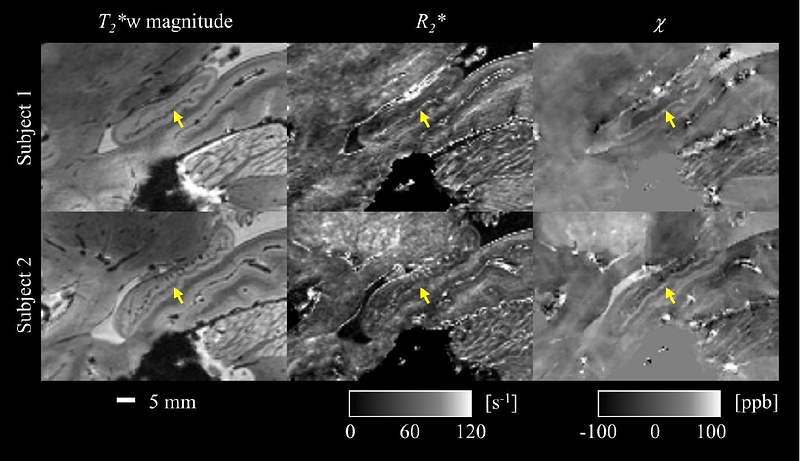Mesoscopic whole-brain T2*-weighted and associated quantitative MRI in healthy humans at 10.5 T

Mesoscopic whole-brain T2*-weighted and associated quantitative MRI in healthy humans at 10.5 T
Liu, J.; Van Gelderen, P.; de Zwart, J. A.; Duyn, J. H.; Huang, Y.; Grant, A.; Auerbach, E.; Waks, M.; Lagore, R. L.; Delabarre, L.; Tarakameh, A. S.; Eryaman, Y.; Adrian, G.; Ugurbil, K.; Wu, X.
AbstractPurpose: To demonstrate the feasibility and performance of mesoscopic whole brain T2*-weighted (T2*w) MRI at 10.5 T by combining a motion-robust multi-echo gradient-echo (GRE) method with high-density RF receive arrays. Methods: Multi-echo GRE data were collected in healthy adults at isotropic 0.5 mm resolution using a custom-built 16-channel transmit/80-channel receive (16Tx/80Rx) RF coil. Whole brain images were reconstructed with navigator-guided joint motion and field correction and were used for quantitative R2* and susceptibility ({chi}) mapping. Intrinsic signal-to-noise ratio (iSNR) and quantification precision for R2* and {chi} were also estimated. The results were compared with those obtained in the same subjects with matched resolution at 7 T using the commercial Nova 1Tx/32Rx coil, to demonstrate the iSNR and quantification precision gains at 10.5 T. G-factors were also calculated at each field strength to evaluate parallel imaging performances. To demonstrate the benefit of increased parallel imaging performances at 10.5 T, whole brain images with higher acceleration were also obtained using a custom-built 16Tx/128Rx coil. Results: the utilized motion robust GRE sequence and reconstruction effectively reduced artifacts from motion and field changes during scans, producing high-quality whole-brain T2*w images and multi-parametric maps at 10.5 T with delineation of fine-scale brain structures. Compared to 7 T, the 10.5 T approach led to gains in both iSNR and quantification precision of R2* and {chi}. Quantitatively, iSNR estimated in the peripheral cortical gray matter increased by 42%. Parallel imaging performances were also improved at 10.5 T owing to the utilized high-density coils compared to the commonly used commercially available coil at 7 T, allowing high-quality images with up to 12-fold combined acceleration when using the 128Rx coil. Conclusion: It is feasible to perform motion-robust whole-brain mesoscopic multi-echo gradient echo imaging of the human brain at 10.5 T. Intrinsic SNR and quantification precision of R2* and {chi} were estimated and compared with 7 T results. The results presented here may shed light on future optimal implementation of anatomic T2*w brain MRI at ultrahigh field beyond 7 T. Keywords: ultrahigh field MRI, 10.5 T, T2*-weighted MRI, high-density RF coil, mesoscopic MRI